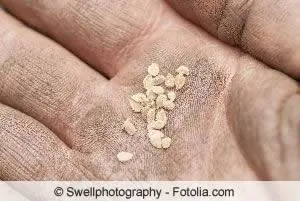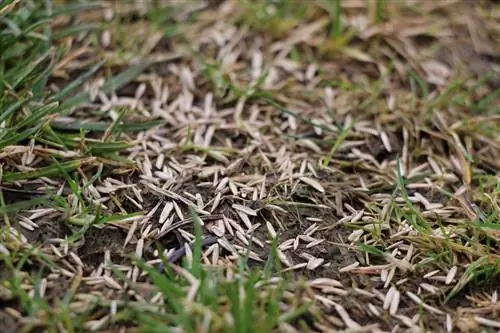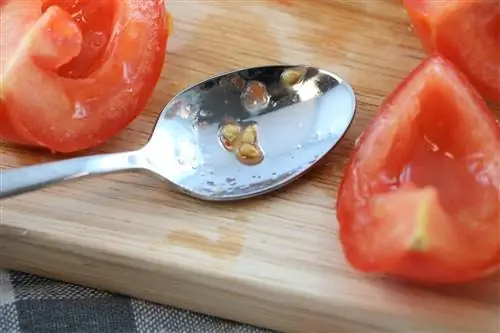- Author admin [email protected].
- Public 2023-12-17 03:39.
- Last modified 2025-01-24 12:45.
Sowing flower seeds is generally quite easy and is a good method for growing new flowers inexpensively. What is important, however, is the correct procedure and the correct time when sowing so that the garden, balcony or terrace shines with colorful flowers in summer. In addition to selecting flowers that suit the site conditions, the seeds must be planted on time and exactly according to the instructions. However, these factors can vary greatly depending on the variety.
Basic rules
Most seeds usually germinate relatively easily and do not require any special treatment. However, there are some types of flowers for which a certain procedure must be followed when sowing in order for them to germinate. A distinction must also be made between seeds purchased from specialist retailers and seeds harvested yourself; with the latter, mold can quickly form. When sowing directly in the garden, the soil must be prepared accordingly; it must be sufficiently loose, but still have enough strength so that there is contact with the deeper and water-bearing soil layer. The following basic rules are important when sowing:
- Clean any fruit residue from self-harvested seeds
- Cover the sowing with soil, about 1-2 times the thickness of the seeds
- Always keep the soil slightly moist
- Direct sowing in the garden or cultivation in living rooms or in the greenhouse possible
- Very sensitive seeds need additional cover to avoid burning
- A layer of brushwood or straw to cover is ideal
- Plant pre-grown plants in the garden or keep them in pots
- Most flower seeds need sufficient heat for the germination process
- Spring is ideal for sowing, pre-breeding in warm conditions is possible in winter
- Some flower varieties only germinate after a cold phase (stratification)
Tip:
Very fine seeds should not be completely covered by soil, but should only be scattered and pressed very lightly.
germination process
After ripening, almost all flower seeds first go through seed dormancy; this process is called dormancy and is essential for germination. During this phase, early germination on the mother plant is prevented and also under unfavorable conditions, such as:B. in winter, avoided. Some seeds can lie in the ground for years until the seed germinates in perfect conditions. To improve germination, seeds with a thick shell should be gently filed on the surface to improve water absorption. Smaller seeds can be rubbed very carefully between extremely fine sandpaper. The following aspects are crucial in the germination process:
- Germination time is the period of time from sowing to germination
- Germination time can vary greatly and can range from 2 days to 90 weeks
- However, most flower seeds germinate relatively quickly
- Sowing requires optimal conditions and appropriate planting substrate in order to germinate
Planting substrate & pricking out
Ideally, special soil from specialist retailers is used for the planting substrate. Alternatively, self-made mixtures of sand or other mineral components are also possible. Tropical flower varieties germinate better in cactus soil; alternatively, a crushed hydroponic substrate can also be used. The high mineral content and the few organic components reduce waterlogging and prevent signs of rot and the formation of mold in the long term. After the flower seeds have germinated and 2-3 pairs of leaves have formed, the seedlings should be transplanted. The following factors play an important role in the planting substrate and when pricking out:
- Special sowing soil is ideal for the germination process
- For seeds with a long germination period, mineral substrates with lots of sand are more suitable
- Tropical seeds need a germ-free planting substrate
- Sterilize homemade mixtures in the oven or microwave
- Keep the substrate moist, but never too wet
- Sink small seedlings a little deeper into the ground after germination
- A special tool is ideal for this, the pikier wood
- To stimulate root formation, water less frequently than often only a little
Tip:
The most common mistake when sowing is over-wet soil. This should not form into a sticky lump, but must crumble easily at all times.
Climate
Most flower seeds need a warm, humid climate to germinate. Floor heating for the base of the pots is of great value; there are also small greenhouses with integrated heating or special heating mats. Hardly any water evaporates in the greenhouse, so there is no need to water constantly. Although there are germ-promoting and anti-fungal preparations available from specialist retailers, they are toxic and have no place in the organic garden. The following aspects are crucial when it comes to climate:
- Cover cultivation pots with foil or use a miniature greenhouse
- The climate in a normal greenhouse is also ideal if it is available in the garden
- Perfect soil temperature for most varieties is between 22-24° C
- Tropical varieties need higher temperatures, approx. 30° C
- Air daily to prevent mold formation
- Bright lighting conditions, but never direct and burning midday sun
- When sowing early, an additional plant lamp is very helpful
- Reflectors made of aluminum foil optimize solar radiation during cloudy weather conditions
Staining

Some flower seeds have difficulty germinating and need special treatment before sowing. This includes, among other things, pickling, which effectively eliminates germ-inhibiting factors. When dressing, the seeds are placed in a liquid that has a germ-promoting effect. In this area, many gardeners have developed their own secret recipes and divergent theories, some of which have become widely accepted:
- Seed dressing with antibacterial solution to avoid harmful rot
- Dilute extracts of valerian, chamomile or horsetail are ideal and biologically acceptable
- Diluted s alt water has proven to be very effective for thick-shelled seeds
- Sometimes an extremely short soak in alcohol helps, maximum 1 minute
- After dressing, always rinse the seeds well
Pilling
By pilling, each seed used is surrounded by a shell, in this way the seeds can be protected from attacks by predators. The coating during pilling can be enriched with antibacterial solutions, nutrients and germ-promoting hormones. Especially if you want to sow over a large area, pelleted seeds guarantee greater germination success. The grains can then even be distributed directly onto the desired area without covering it with plant substrate. In practice, pilling with clay has proven particularly effective, a completely natural process for a sustainable approach:
- Toss seeds with dried and previously ground clay in a bowl
- At the same time, spread water over it with an atomizer
- This creates a thin layer of clay
- Then lay out the seed balls to dry
- Surface of the clay optimizes water absorption and protects the flower seeds
Stratification
Many flower seeds need cold temperatures to germinate, especially the varieties that have adapted to the Central European climate conditions. In this case, nature has set up the germination process so that the seeds only germinate after the winter period. In order to recreate this situation, so-called stratification is used, otherwise the seed will not germinate:
- During the cold period, complex biochemical processes take place inside the seeds
- Germ-causing substances are only formed after stratification
- Store seeds temporarily in either the refrigerator or freezer
- Alternatively, store the flower seeds in a protected place in the garden over the winter
- Depending on the variety, proceed either without or with soil
Conclusion
Many types of flowers can be easily sown in the garden and will sprout on their own with regular watering and suitable site conditions. However, with some flowers, sowing is not so easy and a certain procedure must be followed in order for germination to occur. When sowing, the temperature values, the composition of the soil and the timing are particularly important; these factors can vary greatly depending on the variety. When you purchase flower seeds, detailed planting instructions are usually printed on the package; when it comes to seeds you collect yourself, informative research is extremely important. Otherwise it can happen that the seeds do not germinate at all, for example with cold germinators, which have to be stratified beforehand.






